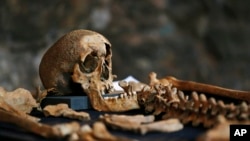The Black Death, a plague that killed up to 60% of people in western Eurasia from roughly 1346 to 1353, likely originated in the Tian Shan mountains of central Asia, new research shows.
Scientists recovered two genomes of an ancient strain of Yersinia pestis, the bacterium that causes plague, from human remains buried in two 14th-century cemeteries in Kyrgyzstan. The strain is the ancestor of the microbes that caused the Black Death.
“The origin of the Black Death has been one of the most widely debated topics not only in medieval history, but I perhaps will not exaggerate if I say that it has been one of the most debated topics in history, period,” said historian and study co-author Philip Slavin of the University of Stirling.
There are many competing theories, he said, “but without ancient DNA, you wouldn't be able actually to confirm one of those theories.”
Researchers reconstructed an ancient Y. pestis genome for the first time in 2011 using samples from a burial ground in London. Since then, a handful of additional Black Death genomes from western Eurasia and many more from modern Y. pestis strains carried by rodents and their parasites — the natural reservoirs of plague — also were sequenced.
But even with the new data, “it was still quite clear to us that this kind of research was not really telling us much about where it all started and when it all started,” said Maria Spyrou, a biologist at the Eberhard Karls University of Tübingen and first author of the new study.
Spike in deaths
The wellspring of the Black Death wouldn’t be found in a European grave. But Slavin thought that two cemeteries near Lake Issyk-Kul in Kyrgyzstan looked promising. Based on tombstone inscriptions, the area saw a spike in deaths between 1338 and 1339. Some of those deaths were blamed on an unknown “pestilence.”
The researchers extracted and sequenced genetic material from seven teeth from seven individuals buried at the cemeteries. Human teeth are crisscrossed by a dense network of blood vessels, making them one of the best places in which to look for the centuries-old DNA of blood-borne pathogens like Y. pestis. Three of the seven individuals had plague DNA in their teeth, allowing researchers to reconstruct the genome of the strain that killed them.
In a genetic family tree of the plague, the new strain sits right at base of what Spyrou called an “explosion of genetic diversity” — a dramatic radiation of new strains including the ones that caused the Black Death. The origin strain’s closest modern cousins are carried by marmots in the surrounding Tian Shan area, so it seems to have developed locally.
“It started most likely in this Tian Shan region of central Asia,” said Spyrou. “But I don’t want to claim that we have found, I don’t know, a patient zero or outbreak zero, because this is almost impossible using the archaeological record.”
Sharon DeWitte, an archaeologist at the University of South Carolina, was excited by the results, but she noted that there’s still a small chance the Black Death reached central Asia from elsewhere.
“Yersinia pestis can travel pretty far without accumulating any genetic variation,” she said. “But that being said, there's strong evidence that that general area was the origin.”
Why, how did it spread?
Finding where the Black Death began is a major step toward understanding why and how it spilled over from animals to humans and spread so catastrophically in the 14th century. Slavin suspects trade was an important factor.
“This community was situated right at the heart of long-distance trade routes known as the Silk Road,” he said. They were “extremely cosmopolitan, very multinational, very multiethnic, and [had] lots of geographic mobility.”
Graves contained pearls from the Pacific and Indian oceans, silks from China or Uzbekistan and shells from the Mediterranean, said Slavin.
Climate could also have been involved, said Spyrou and DeWitte. Future studies of historical climate events in central Asia could help explain the pandemic’s timing and spread. More ancient plague genomes from Asia also would help, but Slavin noted that finding similar archaeological sites or collections isn’t as straightforward as it sounds.
Plague still kills people every year. Because it evolves fast and jumps from animals to humans, it’s important to understand the conditions that make it dangerous and monitor it closely, according to DeWitte. And studying past pandemics can offer lessons for the present, too.
“The Black Death is basically a natural experiment where we are gathering a huge amount of data about the human populations affected, the animals that might have been involved, the bacterium that was involved, and climate conditions,” said DeWitte. “And I think all that's really important in terms of building resilience for populations moving forward so that we don't actually suffer from the worst possible outcomes of pandemic disease.”









